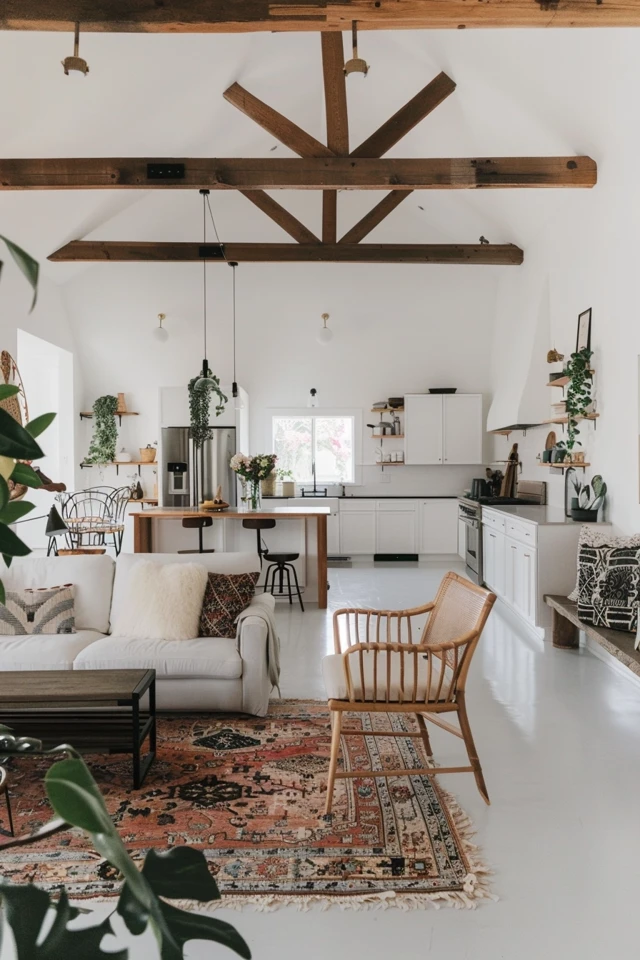When it comes to designing an open floor plan, choosing the right paint colors is crucial in creating a cohesive and inviting space. The colors you use can significantly impact the overall look and feel of the room, setting the tone for your entire home. With a few simple tips and some creative inspiration, you can transform your open floor plan into a stylish and modern living space that reflects your personal style.
Key Takeaways:
- Consider a color palette and choose three colors from the same family to paint the walls.
- Use the same paint sheen on all walls for a cohesive look.
- Create depth by transitioning colors at corners and using architectural features.
- Balance and spread paint colors throughout the space for visual flow.
- Keep the ceiling neutral and use white for trim and woodwork to accent all paint colors equally.

Creating Definition in an Open Floor Plan with Paint
In an open floor plan, it can be challenging to create distinct spaces using paint alone. However, there are other elements and techniques that can be used to define different areas within the open space.
One approach is to use accent colors, furnishings, rugs, and floor coverings to visually separate the living and kitchen areas. By incorporating bold and vibrant colors through these elements, it’s possible to establish a clear division between the two spaces.
Additionally, room dividers or room-dividing furniture can be used strategically to create separation without compromising the flow of the open floor plan. This allows for privacy and definition while maintaining the overall visual flow throughout the space.
Another technique is to use paint placement to delineate different areas. By painting certain architectural features, such as accent walls, tray ceilings, or areas distinguished by trim and millwork, in secondary or statement colors, you can create focal points and visual interest. These colors should complement the primary wall color and enhance the overall visual flow throughout the space.
It’s important to find a balance between bold accent colors and more subdued tones to create a cohesive and harmonious look. By carefully considering color separation and utilizing various design elements, an open floor plan can come to life with defined spaces that maintain a sense of unity.
Overall, with the right paint placement, room dividers, and thoughtful selection of accent colors, an open floor plan can be transformed into a visually appealing and well-defined space that meets both aesthetic and functional needs.

Tips and Considerations for Painting an Open Floor Plan
When painting an open floor plan, it’s important to consider a few key factors to ensure a successful outcome. One of the first considerations is the lighting conditions in the space. Whether your open floor plan is flooded with natural light or on the dim side, it’s essential to take this into account when selecting paint colors. Light colors are often recommended for smaller or dimly lit spaces, but if you prefer a bolder and more intense color, opt for warm undertones. These warm undertones will create a cozy and inviting atmosphere.
Color coordination is another crucial aspect of painting an open floor plan. It’s essential to find the right balance between accent colors and more neutral tones to maintain a cohesive look. To achieve this, limit the number of accent colors to one or two. This will prevent the space from feeling overwhelming or disjointed. To ensure you’re making the right choices, it’s always a good idea to test paint colors in small doses and under different lighting conditions before committing to larger areas.

Experimentation and moderation are important when working with an open floor plan. While it’s fun to try new things and be creative, it’s crucial to do so in moderation. Too many colors or patterns can create visual chaos and make the space feel cluttered. By exercising restraint and focusing on a few key elements, you’ll achieve a more harmonious and visually appealing result.
Another consideration is accent placement. Incorporating accent colors through art and decor is an excellent way to introduce pops of color without long-term commitments. This approach provides flexibility and allows you to change the color scheme easily if desired. Strategically placing accents throughout the space will create visual interest and draw the eye to specific areas.

